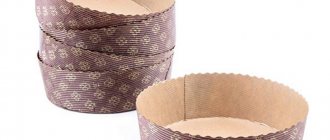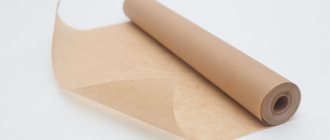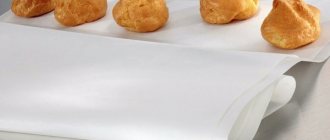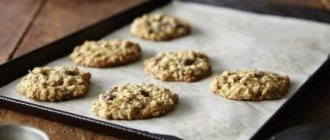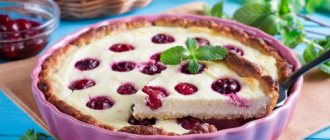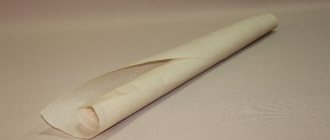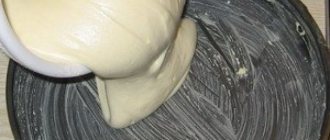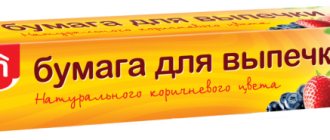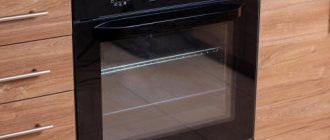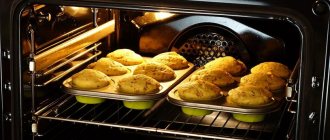Author: Yulia Sabinova. Updated 04/10/2020
When preparing baked goods and baking various products in the oven on a baking sheet, the latter needs an additional coating so that the food does not stick to it and in the future it is easy to clean, so in this review we will look in detail at how and what is the best way to lubricate the baking sheet and how to protect it from burning food.
How to grease a croissant baking tray?
Place the croissants on a greased baking sheet, brush with beaten yolk and bake in an oven preheated to 190 degrees for 20-25 minutes.
Interesting materials:
How to arrange pages in Word? How to make the weather always clear in Minecraft? How to make a constant value in Excel? How to make a permanent cell in Excel? How to make a constant broadcast of music on VK? How to make constant vibration on your phone? How to make permanent 4G on Xiaomi? How to create frayed seams on jeans? How to make scuffs on jeans at home? How to make distressed jeans?
Do I need to lubricate?
Whether or not to lubricate the mold depends on the material from which it is made. It is known that silicone muffin makers only need to be oiled once - before the first use. Subsequently, the dough separates perfectly from the walls and bottom without additional lubrication.
Glass and metal pans need to be greased every time, including non-stick pans. If you don't have butter, use alternative methods, such as baking paper.
How to grease baking pans
Algorithm for greasing a container for baking a delicious cake. What you will need:
| Components | Quantity |
| butter | 10 grams |
| flour | 1 tbsp. l. |
| paper napkin, silicone brush, piece of parchment - optional | — |
How to grease the mold:
- The cut piece is passed along the bottom of the utensil. To ensure that the fat is distributed evenly and there are no dry spots left, use a napkin, parchment or brush.
- Rub the walls thoroughly, but the main thing is not to overdo it. A thick layer will make baked goods high in calories and fat. Carefully check that the dishes are completely coated. You especially need to pay attention to corners and folds. It is to these places that products most often stick.
- Then flour or other powder is poured into the middle of the container.
- Shake the pan so that the flour evenly coats it.
- If there is excess, then get rid of it this way - turn the mold over and tap it a little.
- Place the container in the refrigerator for 5 minutes.
- Then take out and spread the dough.
As a powder, you can use not only different types of flour, but also crackers, semolina, flakes, and cocoa. But experts recommend choosing the product that is included in the test. When baking semolina, the bottom and walls are sprinkled with semolina; if the housewife decides to prepare a chocolate product, then cocoa.
What is the best way to grease a baking dish?
To lubricate the container, it is better to use refined vegetable oil. If you use a product with aroma, it will spoil the taste of the dough. Sunflower oil is the most popular and in demand, but sometimes cooks experiment with flaxseed and sesame oil.
If the product needs to be given a golden crust, then the container and baked goods are coated with butter. It will add a memorable taste to the dish. It is preheated in a water bath. To distribute the mass, use a silicone brush or lubricate the molds with your hands. You may want to wear protective gloves. It is important not to forget to coat the sides of the container with fat.
Margarine is an alternative to butter. This is a budget option that does its job well.
If there is no butter, you can grease the mold with margarine, but it is more harmful than regular butter.
The chef of one Moscow restaurant claims that unsuccessful baking is often not related to the dough, but largely depends on the lubrication of the surface. Butter and margarine contain a small amount of water, so it is better not to use them. It’s smarter to use vegetable oil or fat. You also need to sprinkle the pan with flour so that the dough does not take up excess grease. The flour will act as a barrier between the mixture and the surface of the container.
Experienced cooks, bakers and housewives prepare non-stick grease for molds in advance. It uses the following components:
| Ingredients | Quantity, in grams |
| melted butter | 128 |
| Wheat flour | 90 |
| refined oil (to choose from: vegetable, flaxseed, cottonseed) | 130 |
Step-by-step recipe:
- According to the recipe, wheat flour is used, since it has no unpleasant aftertaste and is ground finely. First combine the cooled ghee and flour. Stir thoroughly with a fork.
Required Ingredients
- The mixture is placed in the refrigerator for 20 minutes.
This was the mixture. She is sent to the refrigerator
- Take it out and put it in a tall glass or bowl.
- Beat with a mixer and gradually, without ceasing to stir, pour in the oil in a thin stream.
- The procedure is a little similar to making mayonnaise. The resulting emulsion is placed in a glass jar with a wide neck.
This is how you should end up with a creamy lubricant.
- The lubricant is sent to a cold place for storage. Some people leave it in the cabinet at room temperature, but it's better to keep it in a cool place.
Shelf-life Unlimited. If the housewife prefers to keep the emulsion in the refrigerator, then before using it, you need to leave it on the table for 5-10 minutes. This will keep the mixture warm and easy to spread.
This substance can be used to coat any coating - for baking bread, rolls, Teflon, cast iron, metal, ceramic. You can also coat the mixer blades in the bread machine - thanks to the mixture, they will come out of the finished product without damaging it.
This mass is convenient to use. It is loved by housewives who often prepare baked goods in molds and on a baking sheet. The mixture never smokes, dishes do not burn and easily come off the surface.
It is not necessary to prepare the emulsion by strictly calculating grams. You can take a cup of each component.
What else can be used to lubricate the container?:
- 100% solid oil;
- melted butter;
- melted pork fat;
- refined vegetable oils - flaxseed, soybean, corn, cottonseed;
- lard - although it contains a lot of fat, it is suitable in a pinch;
- fat with a melting point above 25°C;
- melted coconut oil.
An important requirement is that all products have high melting points. If the dough is liquid, then use soybean or corn oil, since they have virtually no aroma.
Does pan lubrication depend on the type of baked goods?
Lubrication depends not only on the material of the mold, but also on the type of product. If the housewife is going to bake shortbread cake or cookies, then the container does not need to be coated with oil. This is because the dough contains butter or margarine, so it is fatty.
When baking a honey cake, the container is greased and sprinkled with flour. When preparing the casserole, cover the pan with a layer of butter and semolina.
If the housewife decides to bake cake layers in a removable pan, then just cut a circle out of parchment along the diameter of the container and place it on the bottom. When baking a sponge cake, be sure to coat the bottom and walls of the pan, as the dough will rise.
Life hacks, features, nuances, secrets
Some cooks use bran as a powder, especially suitable for baking bread. The rye product will become tastier. There are housewives who want to play it safe and lubricate silicone containers. Experts recommend evenly distributing fat in the following cases:
- if the container is equipped with grooved edges, convex places, recesses, tubercles and depressions;
- the dough itself turns out to be a bit dry and may crumble after cooking in the oven;
- the dough uses a large amount of sugar, jam, jam, honey and other ingredients that are prone to sticking;
- when using cookware for the first time after purchasing it;
- if baking utensils are washed in a dishwasher.
If the pastry chef bakes many portions of muffins or cookies in molds lined with parchment, it is recommended to cool the sheets between batches. If this is not done, the following products will burn. To cool the paper, place it under running water.
When baking pies and casseroles, you should choose a glass pan. It will allow you to monitor the dough, its rise and control its readiness.
Can I use foil instead of parchment paper for baking?
You can replace paper with foil, but you need to know some of the features of its use. If you plan to bake dough products, be sure to grease the foil with oil so that nothing sticks to it. If you are preparing vegetables, fish or meat for baking, then you do not need to smear the foil with oil.
Interesting materials:
What does it take to become a Russian language teacher? What comes first, language or culture? What is emphasized by two lines in Russian? What were the sources of borrowing for the Russian language? What do they teach in 8th grade English? What's the hardest thing about Chinese? What is the vocabulary of a language studied? What is more difficult, Chinese or Japanese? What is alliteration in Russian? What is a Digraph in Latin?
Types of molds
Silicone molds are lubricated with oil only before first use. But glass and metal need protection before each use. This also applies to non-stick coating. If there is no oil at hand, cover the bottom with oiled parchment. You can also find silicone sheet in stores that does not need to be treated with grease.
Answers to popular questions about greasing baking sheets
- Do I need to grease the pan when baking in foil? When baking food in foil (or on foil), there is no need to grease the baking sheet with anything underneath it.
- Do I need to grease the baking sheet when baking in a sleeve in the oven? If you bake foods in a sleeve in the oven (for example, pork, chicken or fish), you do not need to grease the baking sheet.
- Do I need to grease the baking sheet under the parchment? As with using a sleeve and foil, there is no need to grease the baking sheet under the parchment.
- What is the best oil to grease a baking tray? The most popular and universal solution for greasing a baking sheet is the use of refined vegetable oil.
- Do I need to melt the butter before greasing the pan? It is not necessary to melt the butter; you can grease the baking sheet with a “hard” piece of butter.
In conclusion to this review, we can conclude that in the future you will not have problems when baking any baked goods or products in the oven if you know what and how to properly lubricate the baking sheet and protect it from soot. We leave our useful tips and reviews on what is best to use for greasing baking sheets before baking in the comments to this review and share it on social networks if it was useful to you.
Yulia Sabinova
Chief editor of the site. Cook, technologist, traveler. I love to cook, read interesting articles about cooking and proper nutrition, learn new things and share the most interesting things with others. I am glad to see you on the pages of the InfoEda website.
Email for contact
Save on social networks:
Oiled baking tray
Traditionally (and quite successfully) sunflower oil . It’s hard to go wrong with it, unless you choose the unrefined one. It burns more strongly and can give baked goods a specific olive or sunflower flavor . Some housewives experiment with flaxseed and sesame oil to give the dish a special flavor.
Glossy pies can be obtained in two ways: brush with egg or butter. Butter is more flavorful, preserves the dough no worse, and can even be replaced with margarine (just keep in mind that at high temperatures it burns more strongly). In the case of pies, it is better to grease the mold with butter , and if you are preparing quiche, then this is mandatory.
How can you grease a baking sheet to prevent anything from burning?
If you do not use additional “linings”, the baking sheet must be greased and the following are perfect for this purpose:
- Vegetable oil. The most common option for lubricating a baking sheet is with vegetable oil, which is applied to its inner surface in a thin layer using a culinary silicone brush. It is better to use refined oil (odorless and more transparent), which will not affect the taste and aroma of the finished baked goods. Vegetable oil can be used when baking any pies, pies made from puff and yeast dough, Easter cakes, cookies, bread, muffins, biscuits, pizza, when baking fish, meat and other products in the oven.
- Butter. When baking sweet (and other) pastries, it is often recommended to use butter to grease the baking sheet, thanks to which the baked goods do not burn and have a golden brown hue. For lubrication, it is better to choose high-fat butter (from 72.5%), which contains a minimum of liquid and more fat.
- Margarine. Margarine is most often used as a substitute for butter (cheaper), but it has similar properties.
- Pork lard. Fat from melted lard is an excellent protection against baking on the baking sheet, but it is not advisable to use it when preparing sweet baked goods (it may affect the taste). Instead of lard, a baking sheet is often greased with an ordinary piece of fresh lard (salted can also be used), for example: before baking homemade bread or when baking pies with meat or mushrooms.
- Beeswax. A rarer ingredient in the kitchen, but no less effective. Beeswax can reliably protect baked goods while they are baking in the oven; just grease the baking tray with a piece of wax inside and you don’t have to worry about the baked goods burning and sticking.
Note: when using vegetable oil, many housewives additionally sprinkle the baking sheet with a thin layer of flour after greasing it with oil so that the baked goods do not absorb excess oil during cooking.
The baking tray itself can be greased using a silicone brush, a regular pen (the old fashioned way), or by hand, depending on the “lubricant” chosen. For example, it is most convenient to lubricate vegetable oil with a silicone brush or stylus, and harder “lubricants” (butter, lard, margarine) can be put on a fork and grease a baking sheet with them, or you can do it manually (by taking a piece in your hands, you can use gloves, so as not to wash your hands for a long time after such a procedure).
Conclusion: to lubricate the baking sheet, it is best to use sunflower (vegetable) oil and pork lard, while a good option would be to use an additional spacer between the baked goods and the baking sheet (foil or parchment), a lot depends on what will be baked.
What kind of oil to grease the mold with?
It is better to use odorless vegetable oil - refined. The aroma of sunflower or olives can ruin the taste of the dough.
The most popular oil is sunflower oil, some housewives are experimenting with sesame and flaxseed oil.
To get a golden brown crust for the pies, use butter. Melt or soften it first. Butter also adds aroma and pleasant taste.
An inexpensive alternative to butter is margarine. It has no taste or smell, but also does a good job of protecting the dough, although some housewives still experience burning.
To spread, use a silicone culinary brush or grease the mold with your hands while wearing protective gloves. Be sure to cover the sides if the baked goods rise in the oven.
Do I need to grease the baking sheet and why?
When baking any products and dough products in the oven, you should always use additional linings (parchment, foil) or grease the baking sheet with oil or animal fats to avoid sticking and burning of the products to the baking sheet.
Note: in almost every recipe they always indicate what is best to use for greasing a baking sheet, so it is better to follow the advice of the author of the recipe itself, who already has experience baking in the oven and knows whether food burns with this baking method or not.
A good alternative to greasing the baking sheet is to use additional “protection” from food burning, namely:
- Parchment paper. It is recommended to use parchment (parchment paper) when baking dough products (any type of baked goods), since after it the baking sheet remains clean and the baked goods do not burn to it.
- Foil. Culinary foil is an equally effective way to avoid burning; it is used for baking baked goods, meat and other products.
- Silicone pads (mats) and molds. A modern alternative to previous types of “linings” for baking sheets, which do not need to be lubricated with anything and are easy to use.
Let us consider further in more detail how and how to grease a baking sheet so that nothing sticks to it when cooking in the oven.
